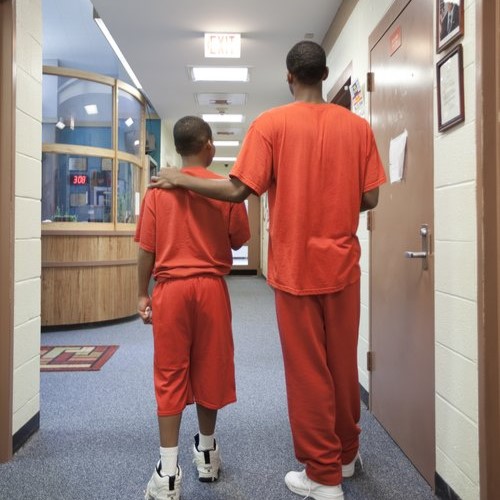
“These juveniles are not innocent children any longer; they are hardened criminals.” — Louisiana Gov. Jeff Landry
“Narrative shapes the way that people think, speak, and behave.” — LCCR Strategic Storyteller Cierra Chenier
In stating the above, Gov. Landry chose to kick off last year’s special legislative session on crime, as well as his new administration, by echoing the same rhetorical demonization of youth that was commonplace during the rise of the mass incarceration era. With new laws passed to treat more kids like adults, more prisons being built to house them, and with harmful amendments being put on the ballot for voters, we can see a new pattern emerging laying the groundwork for another boom in mass incarceration.
We’ve been here before. In the 1990s, historically high violent crime rates coupled with the news media’s persistent demonization of Black urban youth left Americans terrified. This prompted political leaders from both sides of the aisle to call for a new raft of tough-on-crime legislation, culminating in the 1994 Violent Crime Control and Law Enforcement Act. This new law was a major driver of mass incarceration, putting mandatory sentencing minimums in place, authorizing the death penalty for more crimes, and implementing “three strikes laws” that would go on to give many life sentences for nonviolent offenses. Billions in funding was earmarked for prisons and incarceration, increasing the number of adult prisons by 43%.
It was during this era that an academic named John Dilulio published an article describing the “superpredator.” He explained that a “moral poverty” in U.S. cities would result in a flood of 30,000 murderous teenagers, born criminals lacking in empathy or restraint. The media ran with it, often using Black kids as examples of the monsters that Dilulio described.
Notably, the crime wave predicted by Dilulio failed to materialize. Juvenile crime declined significantly in the late-90s and 2000s. In fact, Dilulio has since come to refute his own theory. In the end, it didn’t matter; the term “superpredator” merely gave a shorthand name to a sentiment that has been felt in the United States for centuries—that Black kids are to be feared, adultified, and treated more harshly than their white counter parts. Consider Louisiana Representative Tony Bacala, who recently professed in a House committee meeting about whether it should be easier to send more kids to adult courts and prisons: “Some of these kids are already lost when they’re 2 years old.” This unfounded claim and its troubling context leave us questioning exactly which kids he’s referring to. Whatever his intent, narratives like this disparately impact black children.
Just as it did in the 1990s, the news media continues to disproportionately cover stories about violent crimes committed by Black kids, despite youth crime having steadily declined since spiking in 2022. This coverage fosters a climate of fear and distrust that is out of line with reality. For example, in 2022 and 2023, LCCR informally surveyed community members about what percentage of New Orleans overall arrests consisted of children. Most answered 20-40%. Some answered as high as 80%. The actual number was closer to 10%. But given the disproportionate crime coverage, community members—both Black and white alike—truly believed youth were the primary drivers of all crime. Many still believe that to be the case.
This collective “vibe” about Black youth leads to new laws being passed that focus more on punishment than on actual evidence-based approaches to reducing crime. This is how we get curfew laws, leading to increased interactions between Black teens and the police, and more arrests. This is how we get judges who override their court’s own risk assessment (RAI) scores, leading to more children being jailed for longer. This is how we direct more taxpayer dollars to ankle monitoring instead of rehabilitative programming.
This is also how we get a repeal of the Raise the Age law. 17-year-olds, who were already being transferred to adult courts and jails for certain violent offenses, are now all being prosecuted and jailed as adults regardless of how minor their offense may be. This repeal now denies 17-year-olds access to the proper resources to educate or rehabilitate them.
Notably, this “tough on crime” policy approach does nothing to actually reduce crime. Instead, it wastes taxpayer money while destroying young lives in the process. As we often say here at LCCR: if incarceration truly worked, then Louisiana should already be one of the safest places on the planet. It isn’t. Not by a long shot.
It’s vital that we understand the failings of the past so that we don’t repeat them. While politicians can try to scare us with rhetoric surrounding Black kids, we don’t have to fall for it.
“The superpredator myth was successful in creating a dehumanizing narrative that could be used as justification for harmful, racist polices,” continues Cierra Chenier, LCCR’s Strategic Storyteller. “As history repeats here in Louisiana, it’s imperative that we address how we are witnessing and consuming negative narratives of our kids that deny them of their humanity, adolescence, and healing.”
It’s clear that Louisiana’s current gubernatorial administration has not learned the lesson that draconian laws don’t work to reduce crime. While some efforts (e.g. Amendment 3) may fail to pass, there are already new attempts to try and force more (and younger) children into Louisiana’s prisons. We cannot allow the media to manufacture our consent to harm those most in need of support. We must fight to make our voices heard on behalf of all of Louisiana’s children.